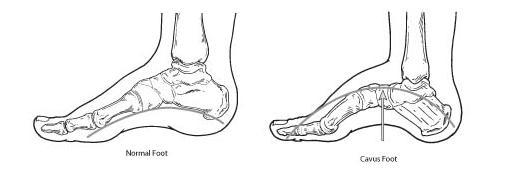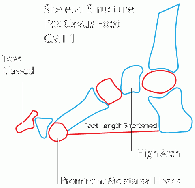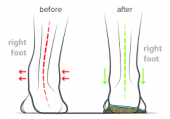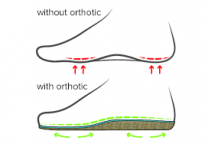Pes Cavus
Original Editor - Sem Bras
Top Contributors - Esraa Mohamed Abdullzaher, Yasmina Hossam, Mathias Plas, Saeed Dokhnan, Uchechukwu Chukwuemeka, Kim Jackson, Admin, Sem Bras, Wendy Walker, George Prudden, Rucha Gadgil and Habibu Salisu Badamasi
Definition[edit | edit source]
Pes cavus is a foot with an abnormally high plantar longitudinal arche. People who have this condition will place too much weight and stress on the ball and heel of the foot while standing and/or walking .
The spectrum of associated deformities observed with pescavus includes clawing of the toes, posterior hind foot deformity (described as an increased calcaneal angle), contracture of the plantar fascia, and cock-up deformity of the great toe. This can cause increased weight bearing for the metatarsal heads and associated Metatarsalgia and calluses. [1]
Etiology[edit | edit source]
The etiology can be attributed to the brain, spinal cord, peripheral nerves, or structural problems of the foot. When motor imbalance begins before maturation of the skeleton, there can be a substantial change in healthy bone morphology. When cavus is acquired after skeletal maturity, there may be little or no change in the morphology. Two thirds of adults with symptomatic cavus foot have an underlying neurologic condition, most commonly : Charcot-Marie-Tooth (CMT) disease ,spinal dysraphism, polyneuritis, Intraspinal tumors, poliomyelitis, syringomyelia, Friedreich ataxia, cerebral palsy, and spinal cord tumors, can cause muscle imbalances that lead to elevated arches. A patient with a new-onset unilateral deformity but without a history of trauma must be evaluated for spinal tumors. .
Types of Pes cavus[edit | edit source]
Three main types of pes cavus are regularly described in the literature: pes cavovarus, pes calcaneocavus, and ‘pure’ pes cavus. The three types of pes cavus can be distinguished by their aetiology, clinical signs and radiological appearance[2]
- Pes cavovarus, the most common type of pes cavus, is seen primarily in neuromuscular disorders such as Charcot-Marie-Tooth disease and, in cases of unknown aetiology, is conventionally termed ‘idiopathic’.[3] Pes cavovarus presents with the calcaneus in varus, the first metatarsal plantarflexed, and a claw-toe deformity.[5] Radiological analysis of pes cavus in Charcot-Marie-Tooth disease shows the forefoot is typically plantarflexed in relation to the rearfoot.[4]
- pes calcaneocavus foot, which is seen primarily following paralysis of the triceps surae due to poliomyelitis, the calcaneus is dorsiflexed and the forefoot is plantarflexed. Radiological analysis of pes calcaneocavus reveals a large talo-calcaneal angle.
- pes cavus, the calcaneus is neither dorsiflexed nor in varus and is highly arched due to a plantarflexed position of the forefoot on the rearfoot.[5] A combination of any or all of these elements can also be seen in a ‘combined’ type of pes cavus that may be further categorized as flexible or rigid.[6]
also Based on location of APEX of the deformity
- Anterior Cavus (Forefoot Cavus) –Local –Global
- Metatarsus cavus
- Posterior Cavus
- Combined
Epidemiology[edit | edit source]
There are few good estimates of prevalence for pes cavus in the general community. While pes cavus has been reported in between 2 and 29% of the adult population, there are several limitations of the prevalence data reported in these studies.[7] Population-based studies suggest the prevalence of the cavus foot is approximately 10% [8]
Pathogenesis[edit | edit source]
Multiple theories have been proposed forthe pathogenesis of pes cavus. Duchenne described intrinsic muscle imbalances causing an elevated arch. Other theories include the extrinsic muscle and acombination of the intrinsic and extrinsic muscles being causes of the imbalance
(1992, Mann) described the pathogenesis of pescavus in patients with CMT disease. An agonist and antagonist model for the muscles determines the deformity. In CMT, the anterior tibialis muscle and the peroneus muscle develop weaknesses. Antagonist muscles, posterior tibialis and peroneus longus, pull harder than the other muscles, causing deformity. Specifically, the peroneus longus pulls harder than the weak anterior tibialis causing plantar flexion of the first ray and forefoot valgus. The posterior tibialis pulls harder than the weak peroneus brevis causing forefoot adduction. Intrinsic muscle develops contractures while the long extensor to the toes, recruited to assist in ankle dorsiflexion, causes cock-up or claw toe deformity. With the forefoot valgus and the hindfoot varus, increased stress is placed on the lateral ankle ligaments and instability can occur.[1]
Clinically relevant Anatomy[edit | edit source]
Clinically it is an abnormal elevation of the medial arch in weight bearing. Biomechanically, cavus is defined as a varus hindfoot, high calcaneal pitch, high-pitched midfoot and plantarflexed and adducted forefoot.
When the angle between the talus and calcaneus is narrowed, the os naviculare moves to a superior position to the cuboid, instead of medial to it. This makes it difficult for the Chopart-joint to function.
The talus is the connector of the foot and the ankle. In a neutral foot, the foot rotates around the talus and the cuboid follows the calcaneus.
Characteristics[edit | edit source]
During the gait cycle, the foot remains locked in hindfoot inversion and forefoot varus throughout the stance phase, causing less stress dissipation. This can result in metatarsalgia, stress fracture of the fifth metatarsal, plantar fasciitis, medial longitudinal arch pain, ilio-tibial band syndrome and instability. This locking and unlocking of the Chopart-joint is a critical element in the cavus-foot.
In an cavus foot, the calcaneus is rotated internally beneath the talus, resulting in an narrow anterior-posterior talo-calcaneal angle. Since the cuboid follows the calcaneus, the cuboid is plantar to the navicular, instead of beside it. This locks the midfoot and overloads the lateral side of the foot .
Another way to look at he chopart function is to view the foot from the front with the forefoot removed . If an axis, drawn through the two joints, is parallel to the ground, there will be relatively free flexion. The more the axis approaches a vertical orientation, the less flexion will be possible.In extremely high-arched feet, the weight bearing is distributed unevenly along the metatarsal heads and the lateral border of the feet. This type of disorder causes the foot to prone to metatarsal head and calcaneal contusions, caused by the excessive pressure of weight bearing. Also the foot is prone to osteophyte formation at the junction of the metatarsal bases and the cuneiforms.
Symptoms and clinical presentation[edit | edit source]
Patients complain pain , instability , difficulty walking and problems with footwear .The symptoms vary with the degree of deformity .[9] also can present with lateral foot pain from increased weight bearing on the lateral foot.
- Metatarsalgia
- keratosis
- Ankle instability
- hindfoot varus
- The forefoot plantar flexion
- hindfoot varus[1]
Medical management[edit | edit source]
Medical management is to allow the patient to ambulate without any problems. It is important the patient to understand that surgical reconstruction does not provide a normal foot. The main goal of surgical reconstruction is to produce a plantigrade foot and pain relief. Repeated surgical procedures can be necessary, especially if the deformity is progressive. Surgical procedures can be broadly categorized into soft-tissue and bony procedures. Tendon transfers and osteotomies can provide correction of the deformity without requiring an arthrodesis.
Clinical Tests[edit | edit source]
- The Coleman block test determines if the subtalar joint is flexible. The testis performed by having a patient stand with a 1-inch wood block under the heel and lateral foot.This allows the first ray to be plantar-flexed off the block. If the hindfoot corrects to a neutral position, the deformity is flexible. If the hindfoot does not correct, the deformity is rigid.
- Increased calcaneal angle[1]
Physiotherapy management [edit | edit source]
Suggested conservative management of patients with painful pes cavus typically involves strategies to reduce and redistribute plantar pressure loading, with use of foot orthoses and specialized cushioned footwear. The orthoses for pes cavus needs to accomplish to several specific goals:
- Increasing plantar surface contact area The overload on the metatarsal heads is a result of limited plantar surface contact due to high arch and limited ankle-joint dorsiflexion. Increasing the plantar surface contact ensures the foot to bear more weight in the arch while the metatarsal heads bear less weight during activity.
- Resisting against excessive supination Lateral ankle stability and laterally deviated subtalar joint axis (STJ) are frequently associated with high-arched feet. This position results in an excessive supinator torque around the subtalar joint axis.
- Resisting against recessive pronation and supination forces Rearfoot instability is caused by an extension of the laterally deviated subtalar axis. In flexible pes cavus, midtarsal flexibility complicates the later portion of the stance pgase of gait. The forefoot pathology produces midtarsal joint supination, that leads to excessive pronation of the rearfoot. Some pes cavus suffer from both lateral ankle instability at midstance and rearfoot pronation at late midstance.
- Orthotics with extra-depth shoes to offload bony prominences and prevent rubbing of the toes may improve symptoms. For varus deformities, a lateral wedge sole modification can improve function. Bracing for supple deformities or foot drop may allow patients to ambulate; however, in patients with sensation deficits, Plastazote linings in the brace are required and frequent inspection of the skin for ulceration is warranted.
Surgical Management[edit | edit source]
- Correcting a cavovarus foot
- Most of the corrections involve tendon transfers and capsular and facial releases
- Correction of plantar flexion of the first ray by performing a dorsiflexion
- ST tarso-metatarsal arthrodesis.
- Reduction of hindfoot varus by performinga lateralizing calcaneal osteotomy.
- Arthrodesis 1st TMT joint, lateral calcaneal osteotomy for hind foot[1]
References[edit | edit source]
- ↑ 1.0 1.1 1.2 1.3 1.4 http://www.physiotherapy-treatment.com/pes-cavus.html
- ↑ Meehan PL. The cavus foot in: Morrisy, RT, (Eds), Lovell and Winter's Pediatric Orthopaedics, J.B. Lippincott, Philadelphia, 1990
- ↑ Giannini S, Ceccarelli F, Benedetti MG, Faldini C, Grandi G. Surgical treatment of adult idiopathic cavus foot with plantar fasciotomy, naviculocuneiform arthrodesis, and cuboid osteotomy. A review of thirty-nine cases. J Bone Joint Surg Am 2002; 84-A: 62-9
- ↑ Aktas S, Sussman MD. The radiological analysis of pes cavus deformity in Charcot Marie Tooth disease. J Pediatr Orthop 2000; 9: 137-40
- ↑ Jahss MH. Evaluation of the cavus foot for orthopedic treatment. Clin Orthop Relat Res 1983; 181: 52-63
- ↑ Coleman SS, Chesnut WJ. A simple test for hindfoot flexibility in the cavovarus foot. Clin Orthop Relat Res 1977; 123: 60-2
- ↑ Burns J. Landorf KB. Ryan MM. Crosbie J. Ouvrier RA. Interventions for the prevention and treatment of pes cavus. Cochrane Database of Systematic Reviews 2007, Issue 4. Art. No.: CD006154. doi:10.1002/14651858.CD006154.pub2
- ↑ Sachithanandam V, Joseph B. The influence of footwear on the prevalence of flat foot. A survey of 1846 skeletally mature persons. J Bone Joint Surg Br 1995; 77: 254-7
- ↑ http://patient.info/doctor/pes-cavus











